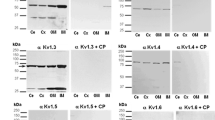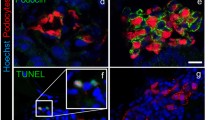Abstract
The podocyte is a remarkable cell type, which encases the capillaries of the kidney glomerulus. Podocytes are of keen interests because of their key roles in kidney development and disease. Large-conductance Ca2+-activated K+ channels (BKCa channels) are important ion channels located in podocytes and play the essential role in regulating calcium homeostasis cell signaling. In this research, we studied the undergoing developmental changes of BKCa channels and their contribution to functional maturation of podocytes. Our results showed that the distribution of BKCa channels changed with the maturity of differentiation in a conditionally immortalized mouse podocyte cell line. Additionally, the increase of BKCa channel protein expression was detected by immunofluorescence staining with confocal microscopy in podocytes, which was consistent with the increase in the current density of BKCa channels examined by whole-cell patch-clamp technique. Our results suggested that the developmental changes of BKCa channels may help podocytes adapt to changes in pressure gradients occurring in physiological conditions. Those findings may have implications for understanding the physiology and development of kidney and will also serve as a baseline for future studies designed to investigate developmental changes of ion channel expression in podocytes.



Similar content being viewed by others
References
Bellardita C.; Bolzoni F.; Sorosina M.; Marfia G.; Carelli S.; Gorio A.; Formenti A. Voltage-dependent ionic channels in differentiating neural precursor cells collected from adult mouse brains six hours post-mortem. J. Neurosci. Res. 2011.
Chiu Y. H.; Alvarez-Baron C.; Kim E. Y.; Dryer S. E. Dominant-negative regulation of cell surface expression by a pentapeptide motif at the extreme COOH terminus of an Slo1 calcium-activated potassium channel splice variant. Mol. Pharmacol. 77: 497–507; 2010.
Drenckhahn D.; Franke R. P. Ultrastructural organization of contractile and cytoskeletal proteins in glomerular podocytes of chicken, rat, and man. Lab Invest 59: 673–682; 1988.
Dryer S. E.; Reiser J. TRPC6 channels and their binding partners in podocytes: role in glomerular filtration and pathophysiology. Am J Physiol Renal Physiol 299: F689–F701; 2010.
Estacion M.; Sinkins W. G.; Jones S. W.; Applegate M. A.; Schilling W. P. Human TRPC6 expressed in HEK 293 cells forms non-selective cation channels with limited Ca2+ permeability. J. Physiol. 572: 359–377; 2006.
Faul C.; Asanuma K.; Yanagida-Asanuma E.; Kim K.; Mundel P. Actin up: regulation of podocyte structure and function by components of the actin cytoskeleton. Trends Cell Biol. 17: 428–437; 2007.
Griffin S. V.; Hiromura K.; Pippin J.; Petermann A. T.; Blonski M. J.; Krofft R.; Takahashi S.; Kulkarni A. B.; Shankland S. J. Cyclin-dependent kinase 5 is a regulator of podocyte differentiation, proliferation, and morphology. Am. J. Pathol. 165: 1175–1185; 2004.
Haller H.; de Groot K.; Bahlmann F.; Elger M.; Fliser D. Stem cells and progenitor cells in renal disease. Kidney Int. 68: 1932–1936; 2005.
Husain M.; Gusella G. L.; Klotman M. E.; Gelman I. H.; Ross M. D.; Schwartz E. J.; Cara A.; Klotman P. E. HIV-1 Nef induces proliferation and anchorage-independent growth in podocytes. J. Am. Soc. Nephrol. 13: 1806–1815; 2002.
Ishizaki M.; Ishiwata T.; Adachi A.; Tamura N.; Ghazizadeh M.; Kitamura H.; Sugisaki Y.; Yamanaka N.; Naito Z.; Fukuda Y. Expression of nestin in rat and human glomerular podocytes. J. Submicrosc. Cytol. Pathol. 38: 193–200; 2006.
Jefferson J. A.; Alpers C. E.; Shankland S. J. Podocyte biology for the bedside. Am J Kidney Dis 58: 835–845; 2011.
Karlsen F. M.; Holstein-Rathlou N. H.; Leyssac P. P. A re-evaluation of the determinants of glomerular filtration rate. Acta Physiol Scand 155: 335–350; 1995.
Kim E. Y.; Alvarez-Baron C. P.; Dryer S. E. Canonical transient receptor potential channel (TRPC)3 and TRPC6 associate with large-conductance Ca2 + −activated K + (BKCa) channels: role in BKCa trafficking to the surface of cultured podocytes. Mol. Pharmacol. 75: 466–477; 2009a.
Kim E. Y.; Chiu Y. H.; Dryer S. E. Neph1 regulates steady-state surface expression of Slo1 Ca(2+)-activated K(+) channels: different effects in embryonic neurons and podocytes. Am J Physiol Cell Physiol 297: C1379–C1388; 2009b.
Kim E. Y.; Choi K. J.; Dryer S. E. Nephrin binds to the COOH terminus of a large-conductance Ca2 + −activated K + channel isoform and regulates its expression on the cell surface. Am J Physiol Renal Physiol 295: F235–F246; 2008.
Kim E. Y.; Dryer S. E. Effects of insulin and high glucose on mobilization of slo1 BKCa channels in podocytes. J. Cell. Physiol. 226: 2307–2315; 2011.
Kim E. Y.; Ridgway L. D.; Dryer S. E. Interactions with filamin A stimulate surface expression of large-conductance Ca2+−activated K+channels in the absence of direct actin binding. Mol. Pharmacol. 72: 622–630; 2007a.
Kim E. Y.; Zou S.; Ridgway L. D.; Dryer S. E. Beta1-subunits increase surface expression of a large-conductance Ca2 + −activated K + channel isoform. J. Neurophysiol. 97: 3508–3516; 2007b.
Kriz W. Podocyte is the major culprit accounting for the progression of chronic renal disease. Microsc. Res. Tech. 57: 189–195; 2002.
Kriz W.; Hackenthal E.; Nobiling R.; Sakai T.; Elger M.; Hahnel B. A role for podocytes to counteract capillary wall distension. Kidney Int. 45: 369–376; 1994a.
Kriz W.; Kretzler M.; Provoost A. P.; Shirato I. Stability and leakiness: opposing challenges to the glomerulus. Kidney Int. 49: 1570–1574; 1996.
Kriz W.; Mundel P.; Elger M. The contractile apparatus of podocytes is arranged to counteract GBM expansion. Contrib. Nephrol. 107: 1–9; 1994b.
Krtil J.; Platenik J.; Kazderova M.; Tesar V.; Zima T. Culture methods of glomerular podocytes. Kidney Blood Press Res 30: 162–174; 2007.
Leapley A. C.; Lee C. C.; Batchelder C. A.; Yoder M. C.; Matsell D. G.; Tarantal A. F. Characterization and culture of fetal rhesus monkey renal cortical cells. Pediatr. Res. 66: 448–454; 2009.
Lu R.; Alioua A.; Kumar Y.; Eghbali M.; Stefani E.; Toro L. MaxiK channel partners: physiological impact. J. Physiol. 570: 65–72; 2006.
Morton M. J.; Hutchinson K.; Mathieson P. W.; Witherden I. R.; Saleem M. A.; Hunter M. Human podocytes possess a stretch-sensitive, Ca2 + −activated K + channel: potential implications for the control of glomerular filtration. J. Am. Soc. Nephrol. 15: 2981–2987; 2004.
Mundel P.; Gilbert P.; Kriz W. Podocytes in glomerulus of rat kidney express a characteristic 44 KD protein. J. Histochem. Cytochem. 39: 1047–1056; 1991.
Mundel P.; Reiser J.; Kriz W. Induction of differentiation in cultured rat and human podocytes. J. Am. Soc. Nephrol. 8: 697–705; 1997.
Pavenstadt H.; Kriz W.; Kretzler M. Cell biology of the glomerular podocyte. Physiol. Rev. 83: 253–307; 2003.
Peti-Peterdi J. Calcium wave of tubuloglomerular feedback. Am J Physiol Renal Physiol 291: F473–F480; 2006.
Quaggin S. E.; Kreidberg J. A. Development of the renal glomerulus: good neighbors and good fences. Development 135: 609–620; 2008.
Ridgway L. D.; Kim E. Y.; Dryer S. E. MAGI-1 interacts with Slo1 channel proteins and suppresses Slo1 expression on the cell surface. Am J Physiol Cell Physiol 297: C55–C65; 2009.
Saleem M. A.; Zavadil J.; Bailly M.; McGee K.; Witherden I. R.; Pavenstadt H.; Hsu H.; Sanday J.; Satchell S. C.; Lennon R.; Ni L.; Bottinger E. P.; Mundel P.; Mathieson P. W. The molecular and functional phenotype of glomerular podocytes reveals key features of contractile smooth muscle cells. Am J Physiol Renal Physiol 295: F959–F970; 2008.
Schiffer M.; Bitzer M.; Roberts I. S.; Kopp J. B.; ten Dijke P.; Mundel P.; Bottinger E. P. Apoptosis in podocytes induced by TGF-beta and Smad7. J. Clin. Invest. 108: 807–816; 2001.
Schiffer M.; Mundel P.; Shaw A. S.; Bottinger E. P. A novel role for the adaptor molecule CD2-associated protein in transforming growth factor-beta-induced apoptosis. J. Biol. Chem. 279: 37004–37012; 2004.
Shankland S. J.; Pippin J. W.; Reiser J.; Mundel P. Podocytes in culture: past, present, and future. Kidney Int. 72: 26–36; 2007.
Vallon V.; Platt K. A.; Cunard R.; Schroth J.; Whaley J.; Thomson S. C.; Koepsell H.; Rieg T. SGLT2 mediates glucose reabsorption in the early proximal tubule. J. Am. Soc. Nephrol. 22: 104–112; 2011.
Vaughan M. R.; Pippin J. W.; Griffin S. V.; Krofft R.; Fleet M.; Haseley L.; Shankland S. J. ATRA induces podocyte differentiation and alters nephrin and podocin expression in vitro and in vivo. Kidney Int. 68: 133–144; 2005.
Acknowledgments
This work was supported by grant from the National Basic Research Program of China (2011CB944003) and the National Natural Science Foundation of China (31271074). And we would like to thank Prof. Peter Mundel for his podocyte cell line.
Conflict of interests
The authors declare no competing interests.
Author information
Authors and Affiliations
Corresponding author
Additional information
Editor: T. Okamoto
Jiajia Yang and Pengjuan Xu contributed equally to this work.
Rights and permissions
About this article
Cite this article
Yang, J., Xu, P., Xie, Y. et al. Developmental changes of BKCa channels depend on differentiation status in cultured podocytes. In Vitro Cell.Dev.Biol.-Animal 49, 205–211 (2013). https://doi.org/10.1007/s11626-013-9590-8
Received:
Accepted:
Published:
Issue Date:
DOI: https://doi.org/10.1007/s11626-013-9590-8




